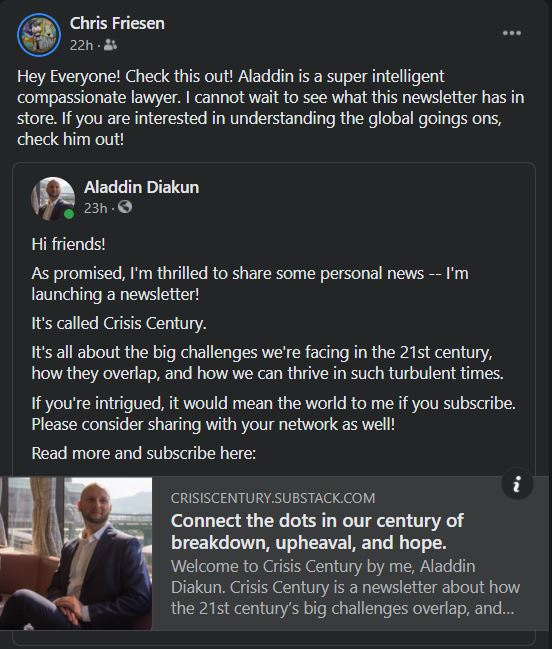About CRISIS CENTURY
“It’s the convergence of stresses that’s especially treacherous and makes synchronous failure a possibility as never before. In coming years, our societies won’t face one or two major challenges at once, as usually happened in the past. Instead, they’ll face an alarming variety of problems … all at the same time.”
— Thomas Homer-Dixon, “The Upside of Down” (2006).
Our crises are connected.
From global finance to global terrorism, transnational crises aren’t new.
But in the 21st century, meaningful diagnosis and treatment demands holistic thinking — we have to connect the dots.
Our environmental, social, economic, and political systems are profoundly interwoven. A crisis in one can easily cascade across the others. With so many systems facing concurrent pressures, the risk of “synchronous failure” — breakdowns in multiple systems at once — has never been higher.
The global COVID pandemic has shown that we can’t afford to ignore big trends and scientific warnings, and that we can’t treat our major challenges as though they exist in isolation. They don’t.
We know, for example, that it’s simply not possible to separate the pandemic from the urgent fight for racial justice.
Nor can we understand financial market stability without talking about physical climate change risks, stranded assets, and the massive reallocation of capital that is already underway.
Similarly, if we’re to manage US border anxieties and turn the tide against extremism and authoritarianism, we should probably talk a lot more about drought, water scarcity, and food security in Central America as well as privacy, algorithmic transparency, and technology regulation.
Too often, these stories are fragmented and siloed — if they’re told at all.
And many of us are far too busy to sift through the noise and find the signal.
When you sign up, you’ll get weekly curated news, analysis, and original commentary on the major trends and crises we’re facing so that you never miss the big picture.
My goal is to help you better understand where we are and where we’re headed, and to empower you to face the landscape of risks and opportunities ahead.
I want to help you thrive amid our century of overlapping crises.
Crisis is our new normal.
“That’s why you start where you are. Not where you wish you were. Not where you hope you are. Not where you think you should be. But right where you are.”
— Bill Burnett & Dave Evans, “Designing Your Life” (2016).
This isn’t a newsletter about overwhelming doom and gloom. But to thrive in the 21st century, as individuals, businesses, societies, and as a global community, we must be clear-eyed about where we are right now — and about where our current choices are taking us.
We can no longer abide the comfortable illusion that things will “calm down” or “get back to normal,” or that we can “figure it out later.”
Crisis is our normal now — it will be for the rest of our lives.
This is true particularly because climate change is the great threat multiplier, igniting financial fuel and political tinder that might otherwise simply smolder.
We need a societal growth mindset.
“So where do we go from here? First, we take a breath. It’s a lot. And in some ways, we, humans, were not designed for a crisis this massive and all-encompassing. In other ways, we were made for this moment. What we do now is dream. From a foundation of science and community, we must imagine the future we want to live in, and the future we want to pass on, and every day do something to reel the dream closer to reality.”
— Ayana Elizabeth Johnson and Katharine K. Wilkinson, “All We Can Save” (2020).
We were already in a spiral before the pandemic.
From gerrymandering to gender-based violence, student debt to superstorms, maritime pollution to mental health, the old normal wasn’t working and the status quo had us on a path to civilizational ruin.
What’s the alternative? We must choose to grow, together. It’s time to level up.
Has a crisis ever shaken you to your core, so that you had to re-examine your values, assumptions, and identity? Had to cultivate new habits and patterns of relating in the world? A crisis that made you slough off what wasn’t working so you could grow?
That’s where we all are now. Individually, and collectively. And that’s the exciting part.
For every oil company facing catastrophic write-downs and lawsuits, there are dozens of new business opportunities awaiting the right entrepreneurs.
And for all the uncertainty and hardship ahead, we have the historic privilege of fighting for a future worth leaving to our grandchildren. We get to decide what we’ll be remembered for. What a moment to be alive.
We have a world to win, and the boundless opportunity of our collective potential to unleash.
Will you join me?
About Aladdin

I’m a millennial lawyer coming through the far side of burnout.
I’ve worked for Greenpeace, in academia, with a leading think tank, and on Bay Street — as well as countless service jobs.
I speak a few languages, and I have degrees in political science, global governance, and law.
I also help out with the Suntory Foundation’s Reexamining Japan in Global Context Project.
I live in Toronto (“tkaronto”, home of the Mississaugas of the Credit) with my incredibly supportive partner and our sweet little rescue, Ruthie!

I’ll be sharing more about my journey in the first edition of this newsletter. In the meantime, profound, enduring thanks to everyone who has encouraged me to do this.
What are people saying about CRISIS CENTURY?
There’s already been some terrific feedback pre-launch.






